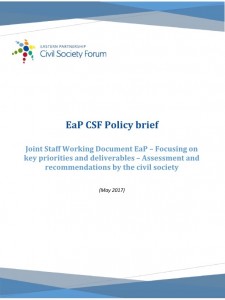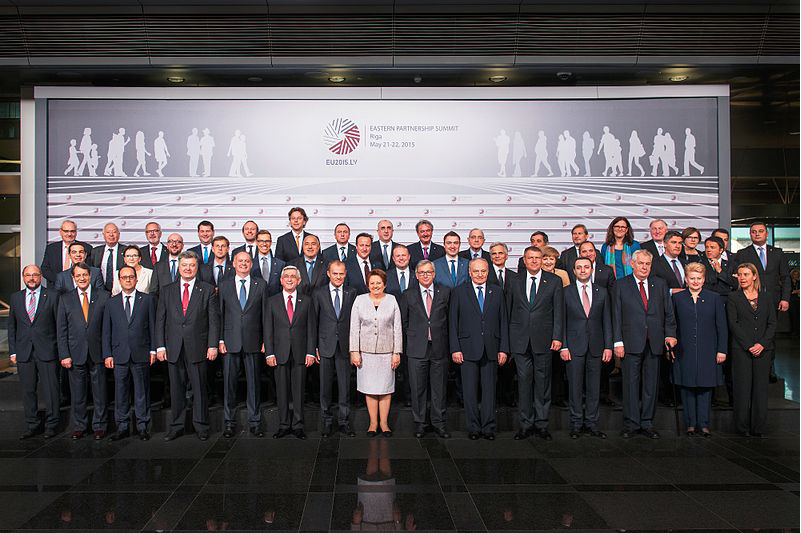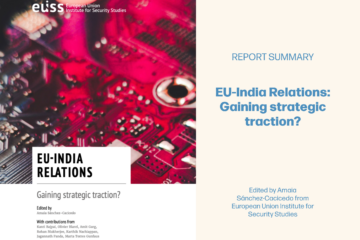Eastern Partnership 2017 Summit
[:en]Assessment of ‘Eastern Partnership- Focusing on key priorities and deliverables’ by the EaP Civil Society Forum
In a world of increasing political and economic interdependence, cooperation and partnerships have come to play a key role in modern global politics. Partnerships are a two-way mutual relationship where deeper integration among partners is envisioned based on specific goals and interests. With this line of thought, the European Union (EU) continues to work on creating the necessary ties and relationships with its neighbours to ensure stability, security, and prosperity.
The Eastern Partnership (EaP) is an initiative between the EU and six Eastern partner countries: Armenia, Georgia, the Republic of Moldova, Belarus, Azerbaijan, and Ukraine. Established in 2009, the EaP aims at creating a forum for the political cooperation and economic integration of these countries. With the Eastern Partnership 2017 Summit on its way, focus has turned to the paper delivered by the European External Action Service and the European Commission, where they outlined 20 deliverables they envision to see by 2020.
The EaP summit is set to take place in Brussels on 24 November, and it intends to follow up on the key priorities agreed in the last summit in Riga 2015. The 20 deliverables for 2020 were initially published in December 2016 and were later revised in June 2017, and are thought to “identify concrete tangible results for citizens, on the basis of already agreed commitments.” The four key priority areas are:
- Economic development and market opportunities
- Strengthening institutions and good governance
- Connectivity, energy efficiency, environment and climate change
- Mobility and people-to-people contacts
The 20 deliverables provide a work plan not only for the 2017 summit but also for the EaP performance until 2020. Although many of these priorities are issues that have been looked at for a long time, there is an emphasis to push for strategic communication and support to independent media, gender equality and women empowerment, sustainability and climate change, economic openness, and harmonisation of digital markets. Furthermore, there is interest in fully aligning policy and its implementation by means of bilateral and multilateral cooperation.
With the intention of opening public debate, the Eastern Partnership Civil Society Forum conducted a detailed analysis of the paper outlining these 20 deliverables. They question the feasibility, ambitiousness, appropriateness, risks, and differentiation of the deliverables. Another question that comes to mind is how does the absence of Russia and Turkey in this partnership shift any power balances? Does their absence create advantages or limitations? These questions should provide the measuring basis for all stakeholders to report on achievements and challenges as the ground to continue the work between the EU and EaP in the future.
Read more here:
 [:da]Assessment of ‘Eastern Partnership- Focusing on key priorities and deliverables’ by the EaP Civil Society Forum
[:da]Assessment of ‘Eastern Partnership- Focusing on key priorities and deliverables’ by the EaP Civil Society Forum
In a world of increasing political and economic interdependence, cooperation and partnerships have come to play a key role in modern global politics. Partnerships are a two-way mutual relationship where deeper integration among partners is envisioned based on specific goals and interests. With this line of thought, the European Union (EU) continues to work on creating the necessary ties and relationships with its neighbours to ensure stability, security, and prosperity.
The Eastern Partnership (EaP) is an initiative between the EU and six Eastern partner countries: Armenia, Georgia, the Republic of Moldova, Belarus, Azerbaijan, and Ukraine. Established in 2009, the EaP aims at creating a forum for the political cooperation and economic integration of these countries. With the Eastern Partnership 2017 Summit on its way, focus has turned to the paper delivered by the European External Action Service and the European Commission, where they outlined 20 deliverables they envision to see by 2020.
The EaP summit is set to take place in Brussels on 24 November, and it intends to follow up on the key priorities agreed in the last summit in Riga 2015. The 20 deliverables for 2020 were initially published in December 2016 and were later revised in June 2017, and are thought to “identify concrete tangible results for citizens, on the basis of already agreed commitments.” The four key priority areas are:
- Economic development and market opportunities
- Strengthening institutions and good governance
- Connectivity, energy efficiency, environment and climate change
- Mobility and people-to-people contacts
The 20 deliverables provide a work plan not only for the 2017 summit but also for the EaP performance until 2020. Although many of these priorities are issues that have been looked at for a long time, there is an emphasis to push for strategic communication and support to independent media, gender equality and women empowerment, sustainability and climate change, economic openness, and harmonisation of digital markets. Furthermore, there is interest in fully aligning policy and its implementation by means of bilateral and multilateral cooperation.
With the intention of opening public debate, the Eastern Partnership Civil Society Forum conducted a detailed analysis of the paper outlining these 20 deliverables. They question the feasibility, ambitiousness, appropriateness, risks, and differentiation of the deliverables. Another question that comes to mind is how does the absence of Russia and Turkey in this partnership shift any power balances? Does their absence create advantages or limitations? These questions should provide the measuring basis for all stakeholders to report on achievements and challenges as the ground to continue the work between the EU and EaP in the future.
Read more here:



